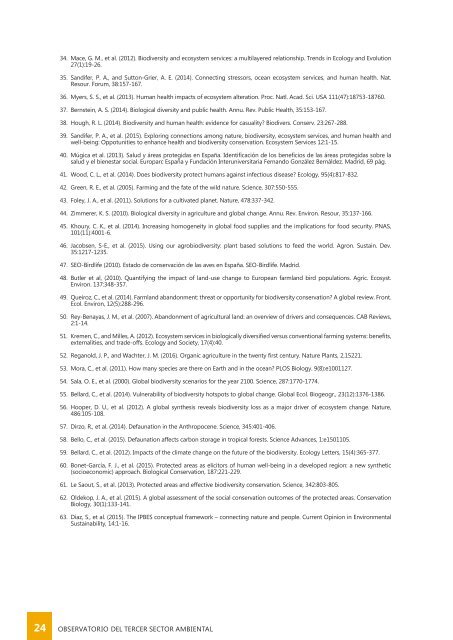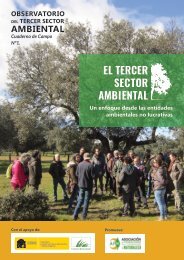IMPORTANCIA SOCIAL DEL MEDIO AMBIENTE Y LA BIODIVERSIDAD
1e6V30342OE
1e6V30342OE
You also want an ePaper? Increase the reach of your titles
YUMPU automatically turns print PDFs into web optimized ePapers that Google loves.
34. Mace, G. M., et al. (2012). Biodiversity and ecosystem services: a multilayered relationship. Trends in Ecology and Evolution<br />
27(1):19-26.<br />
35. Sandifer, P. A., and Sutton-Grier, A. E. (2014). Connecting stressors, ocean ecosystem services, and human health. Nat.<br />
Resour. Forum, 38:157-167.<br />
36. Myers, S. S., et al. (2013). Human health impacts of ecosystem alteration. Proc. Natl. Acad. Sci. USA 111(47):18753-18760.<br />
37. Bernstein, A. S. (2014). Biological diversity and public health. Annu. Rev. Public Health, 35:153-167.<br />
38. Hough, R. L. (2014). Biodiversity and human health: evidence for casuality? Biodivers. Conserv. 23:267-288.<br />
39. Sandifer, P. A., et al. (2015). Exploring connections among nature, biodiversity, ecosystem services, and human health and<br />
well-being: Oppotunities to enhance health and biodiversity conservation. Ecosystem Services 12:1-15.<br />
40. Múgica et al. (2013). Salud y áreas protegidas en España. Identificación de los beneficios de las áreas protegidas sobre la<br />
salud y el bienestar social. Europarc España y Fundación Interuniversitaria Fernando González Bernáldez. Madrid, 69 pág.<br />
41. Wood, C. L., et al. (2014). Does biodiversity protect humans against infectious disease? Ecology, 95(4):817-832.<br />
42. Green, R. E., et al. (2005). Farming and the fate of the wild nature. Science, 307:550-555.<br />
43. Foley, J. A., et al. (2011). Solutions for a cultivated planet. Nature, 478:337-342.<br />
44. Zimmerer, K. S. (2010). Biological diversity in agriculture and global change. Annu. Rev. Environ. Resour, 35:137-166.<br />
45. Khoury, C. K., et al. (2014). Increasing homogeneity in global food supplies and the implications for food security. PNAS,<br />
101(11):4001-6.<br />
46. Jacobsen, S-E., et al. (2015). Using our agrobiodiversity: plant based solutions to feed the world. Agron. Sustain. Dev.<br />
35:1217-1235.<br />
47. SEO-Birdlife (2010). Estado de conservación de las aves en España. SEO-Birdlife. Madrid.<br />
48. Butler et al, (2010). Quantifying the impact of land-use change to European farmland bird populations. Agric. Ecosyst.<br />
Environ. 137:348-357.<br />
49. Queiroz, C., et al. (2014). Farmland abandonment: threat or opportunity for biodiversity conservation? A global review. Front.<br />
Ecol. Environ, 12(5):288-296.<br />
50. Rey-Benayas, J. M., et al. (2007). Abandonment of agricultural land: an overview of drivers and consequences. CAB Reviews,<br />
2:1-14.<br />
51. Kremen, C., and Milles, A. (2012). Ecosystem services in biologically diversified versus conventional farming systems: benefits,<br />
externalities, and trade-offs. Ecology and Society, 17(4):40.<br />
52. Reganold, J. P., and Wachter, J. M. (2016). Organic agriculture in the twenty first century. Nature Plants, 2,15221.<br />
53. Mora, C., et al. (2011). How many species are there on Earth and in the ocean? PLOS Biology. 9(8):e1001127.<br />
54. Sala, O. E., et al. (2000). Global biodiversity scenarios for the year 2100. Science, 287:1770-1774.<br />
55. Bellard, C., et al. (2014). Vulnerability of biodiversity hotspots to global change. Global Ecol. Biogeogr., 23(12):1376-1386.<br />
56. Hooper, D. U., et al. (2012). A global synthesis reveals biodiversity loss as a major driver of ecosystem change. Nature,<br />
486:105-108.<br />
57. Dirzo, R., et al. (2014). Defaunation in the Anthropocene. Science, 345:401-406.<br />
58. Bello, C., et al. (2015). Defaunation affects carbon storage in tropical forests. Science Advances, 1:e1501105.<br />
59. Bellard, C., et al. (2012). Impacts of the climate change on the future of the biodiversity. Ecology Letters, 15(4):365-377.<br />
60. Bonet-García, F. J., et al. (2015). Protected areas as elicitors of human well-being in a developed region: a new synthetic<br />
(socioeconomic) approach. Biological Conservation, 187:221-229.<br />
61. Le Saout, S., et al. (2013). Protected areas and effective biodiversity conservation. Science, 342:803-805.<br />
62. Oldekop, J. A., et al. (2015). A global assessment of the social conservation outcomes of the protected areas. Conservation<br />
Biology, 30(1):133-141.<br />
63. Díaz, S., et al. (2015). The IPBES conceptual framework – connecting nature and people. Current Opinion in Environmental<br />
Sustainability, 14:1-16.<br />
24 OBSERVATORIO <strong>DEL</strong> TERCER SECTOR AMBIENTAL



